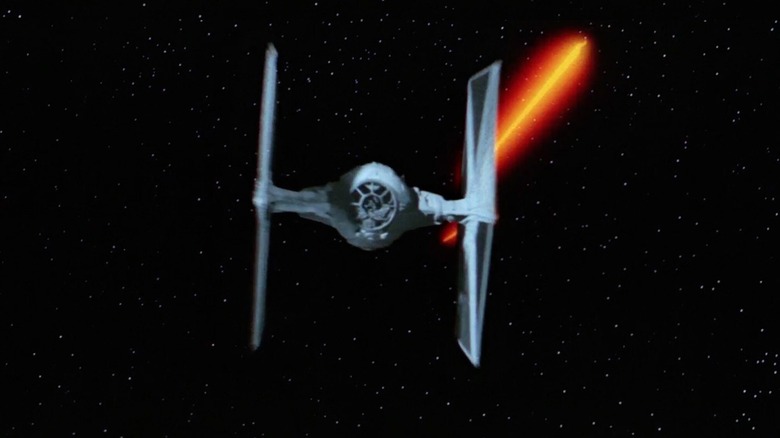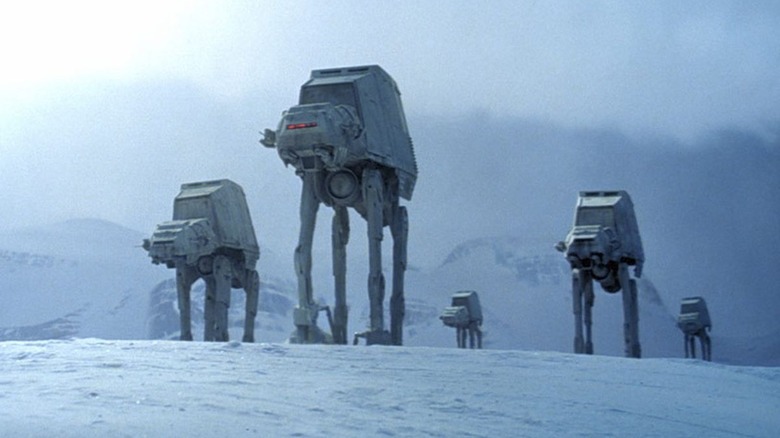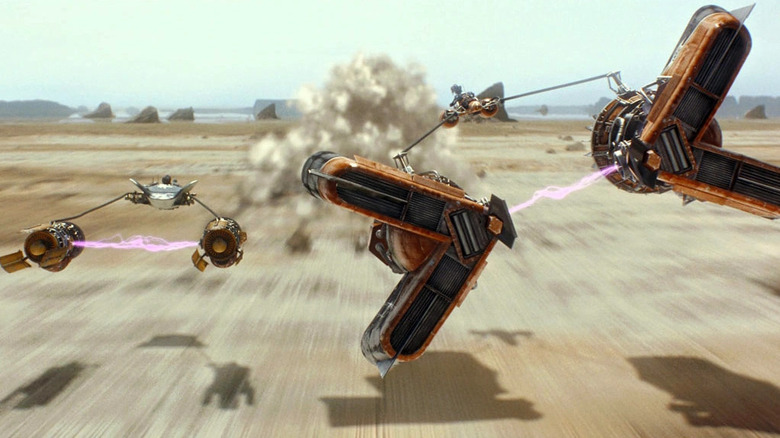The TIE In Star Wars' TIE Fighter Is Actually An Acronym, But What Does It Stand For?
To answer the question right away, TIE stands for "twin ion engines." The large, fan-shaped "wings" on the Empire's light attack craft in the original "Star Wars" were, in fact, the vehicles' engines. The design of the craft is canny, as the pilot sits in between the two fan-shaped engines and peers out through a round, iris-like window. The Empire, being the film's villains, look like they're flying around inside of creepy eyeballs. The heroic Rebels, meanwhile, fly around in X-Wing fighters, which look a lot more like traditional, cone-shaped airplanes and rockets from Earth. They also sport a quartet of small, round jet engines on their four wings, making the X-Wings look deliberately similar to known warplanes. Visually, an audience will likely instantly side with the more traditional planes over the creepy eyeballs.
Unlike Star Trek, Star Wars rarely delves into the technical details of how their ships actually are meant to function. How fast, for instance, is "hyperspace?" Is it the speed of light? If so, wouldn't that make their galaxy incredibly small? It would take four and a half years, for instance, to travel from Earth to Alpha Centauri if one can only go the speed of light. It seems, then, that hyperspace travel would go through wormholes, although there is no mention of folding space or wormhole technology. Indeed, there are few scenes in Star Wars films or TV shows that explain such technical things in plain English.
The twin ion engines, then, are a technology that employs charged particles for locomotion abilities. They can't make the ship travel any faster than they would need to go in a dogfight scenario, and they only seat one pilot. They shoot green laser blasts. That's all the audience is meant to know.
AT-ATs, Artoo, and Threepio
When it comes to vehicles and spacecraft in Star Wars, form is far more important than function. The Empire's vehicles tend to be large, blocky, and intimidating. They need to look like walls or guns or stabbing weapons. That they don't make a lot of sense from a practical design perspective isn't important. The AT-ATs from "The Empire Strikes Back," for instance, are just really neat-looking. They are massive, forward-assault tanks that walk around on tall, giraffe-like legs. How is that more practical than a tank? It isn't, but it looks otherworldly. Later in the series, in "Rogue One: A Star Wars Story," it was established that Star Destroyers could enter a planet's atmosphere and hover in place. Why mess around with tanks and AT-ATs at all when a massive warship can descend from the heavens and lay waste to any potential Rebel base?
AT-AT, incidentally, stands for "all-terrain armored transport." The smaller, two-legged AT-STs are "all-terrain scout transports." These abbreviations are typically found in expanded universe lore, and are recorded in sourcebooks like Landry Q. Walker's "Star Wars Encyclopedia of Starfighters and Other Vehicles."
The droid R2-D2's name translates to the fact that it is the second generation robotic droid, and is of series-2. It has been established, however, that the droid's name was taken from real-life filmmaking technical speak when sound editor Walter Murch asked for reel two, dialogue track two — R2-D2 — while working on "American Graffiti." C-3PO, meanwhile, doesn't have a more elaborate meaning than he is a C-series droid, with a serial number of 3PO. NASA, however, in the character's honor, named one of their divisions the Commercial Crew and Cargo Program Office, or C3PO for short.
Other vehicles
Also unlike Star Trek, many ships in Star Wars don't really have names. They are typically called by what they are, rather than being specially christened. Podracers are merely podracers. Landspeeders speed across the land. Bongos are submarines. A Republic LAAT gunship is a gunship used by the Republic. (LAAT stands for low-altitude assault transport.)
In 1999's "Star Wars: Episode I — The Phantom Menace," characters can be seen on STAPs, or single-trooper aerial platforms. In "Star Wars: Episode II — Attack of the Clones," one might have seen a SPHA, or self-propelled heavy artillery. MTT vehicles provide multi-troop transport. In "Star Wars: Episode III — Revenge of the Sith," droid warriors use an HMP Droid gunship, which has a heavy missile platform. Smaller flying craft seen on Hoth were called T-47's, although that name has no special significance.
The most memorable ship in Star Wars is probably the Millennium Falcon, a quick-moving flying saucer. According to expanded lore, the ship flown by Han Solo is a Corellian YT-1300F light freighter, but one that had been massively overhauled and redesigned over the years. It also, as seen in the film "Solo: A Star Wars Story," once possessed an escape pod that Han never bothered to replace. Its original name was the Stellar Envoy. The Corellian Engineering Corporation isn't mentioned much in the main Star Wars films and TV shows, but a deep-cut Starwoid will know they are the ones who constructed a lot of the ships and freighters seen in the backgrounds of many of the franchise's films and shows.
As of "The Rise of Skywalker," the Millennium Falcon appears to be about a century old. It's like a souped-up Toyota, in that a driver can't seem to kill it, no matter how many oil changes they skip.


